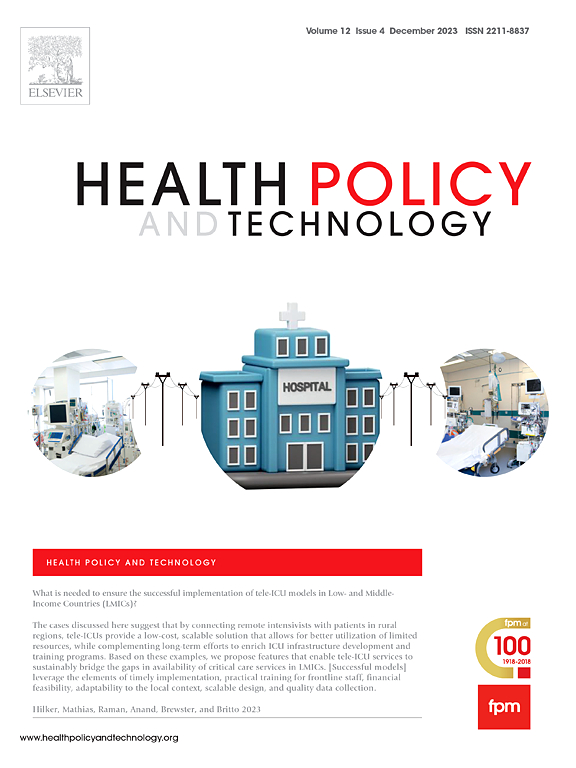How has Aggregated Mobility Data-informed public health research?
IF 3.7
3区 医学
Q1 HEALTH POLICY & SERVICES
引用次数: 0
Abstract
Objective
The widespread adoption of smartphones has enabled the collection and analysis of population-level mobility patterns through Aggregated Mobility Data. This type of data, which is derived from both operator and crowdsourced sources, presents opportunities and challenges for public health research. This data derived from both operator and crowdsourced sources, presents opportunities and challenges for public health research. We explore how this novel data source has been used in public health studies, its benefits, limitations, and ethical considerations.
Methods
We conducted a narrative review of Aggregated Mobility Data applications in public health research, critically examining its potential and challenges. A systematic search of Embase and Google Scholar identified 645 peer-reviewed primary research articles. We included English peer-reviewed and primary research published between 2010–2024 where aggregated mobility data was being used to evaluate a public health outcome. After applying inclusion criteria, 95 studies were included for narrative synthesis and descriptive quantitative analysis.
Results
We found the majority of studies to date using Aggregated Mobility Data were related to COVID-19. Reporting of ethical and privacy considerations varied widely, with some studies undergoing formal ethics review and others citing exemptions based on the use of anonymized or aggregate data. Key limitations of Aggregated Mobility Data included restricted access to data sources and challenges associated with small population sizes.
Conclusion
This review underscores the potential of Aggregated Mobility Data in public health research and highlights key considerations for researchers and policymakers. Future studies should address ethical standardization, data accessibility, and broader applications beyond infectious disease surveillance to fully leverage the utility of Aggregated Mobility Data in public health decision-making.
Public Interest Summary
With the rise of smartphones, researchers can now track population movement using Aggregated Mobility Data from mobile devices. This data has been widely used in public health, especially during COVID-19, to understand how people move and how that impacts disease spread. However, access to this data is often restricted, and ethical considerations like privacy protections vary across studies. Our review examined 95 studies to assess the applications in public health research. While this data offers valuable insights, future research should focus on standardizing ethical guidelines, improving data access, and expanding its use beyond infectious disease tracking to other public health challenges.
综合流动数据如何为公共卫生研究提供信息?
智能手机的广泛采用使得通过汇总移动数据收集和分析人口水平的移动模式成为可能。这类数据来自运营商和众包来源,为公共卫生研究带来了机遇和挑战。这些数据来自运营商和众包来源,为公共卫生研究带来了机遇和挑战。我们将探讨这种新的数据来源是如何在公共卫生研究中使用的,它的益处、局限性和伦理考虑。方法:我们对汇总移动数据在公共卫生研究中的应用进行了叙述性回顾,批判性地考察了其潜力和挑战。对Embase和b谷歌Scholar的系统搜索确定了645篇同行评议的初级研究文章。我们纳入了2010-2024年间发表的英语同行评议和初级研究,这些研究使用了汇总的流动性数据来评估公共卫生结果。应用纳入标准,纳入95项研究进行叙事综合和描述性定量分析。结果我们发现,迄今为止使用汇总流动性数据的大多数研究都与COVID-19有关。关于伦理和隐私考虑的报告差异很大,一些研究经过了正式的伦理审查,而另一些研究则基于使用匿名或汇总数据而获得豁免。汇总流动数据的主要限制包括对数据源的访问受限以及与人口规模小相关的挑战。结论:本综述强调了汇总流动数据在公共卫生研究中的潜力,并强调了研究人员和政策制定者需要考虑的关键因素。未来的研究应解决伦理标准化、数据可及性以及传染病监测以外的更广泛应用,以充分利用聚合流动性数据在公共卫生决策中的效用。随着智能手机的兴起,研究人员现在可以使用来自移动设备的汇总移动数据来跟踪人口流动。这些数据已被广泛用于公共卫生领域,特别是在COVID-19期间,以了解人们如何移动以及如何影响疾病传播。然而,对这些数据的访问往往受到限制,隐私保护等伦理考虑在不同的研究中有所不同。我们回顾了95项研究,以评估其在公共卫生研究中的应用。虽然这些数据提供了有价值的见解,但未来的研究应侧重于规范伦理准则,改善数据获取,并将其应用范围从传染病追踪扩展到其他公共卫生挑战。
本文章由计算机程序翻译,如有差异,请以英文原文为准。
求助全文
约1分钟内获得全文
求助全文
来源期刊

Health Policy and Technology
Medicine-Health Policy
CiteScore
9.20
自引率
3.30%
发文量
78
审稿时长
88 days
期刊介绍:
Health Policy and Technology (HPT), is the official journal of the Fellowship of Postgraduate Medicine (FPM), a cross-disciplinary journal, which focuses on past, present and future health policy and the role of technology in clinical and non-clinical national and international health environments.
HPT provides a further excellent way for the FPM to continue to make important national and international contributions to development of policy and practice within medicine and related disciplines. The aim of HPT is to publish relevant, timely and accessible articles and commentaries to support policy-makers, health professionals, health technology providers, patient groups and academia interested in health policy and technology.
Topics covered by HPT will include:
- Health technology, including drug discovery, diagnostics, medicines, devices, therapeutic delivery and eHealth systems
- Cross-national comparisons on health policy using evidence-based approaches
- National studies on health policy to determine the outcomes of technology-driven initiatives
- Cross-border eHealth including health tourism
- The digital divide in mobility, access and affordability of healthcare
- Health technology assessment (HTA) methods and tools for evaluating the effectiveness of clinical and non-clinical health technologies
- Health and eHealth indicators and benchmarks (measure/metrics) for understanding the adoption and diffusion of health technologies
- Health and eHealth models and frameworks to support policy-makers and other stakeholders in decision-making
- Stakeholder engagement with health technologies (clinical and patient/citizen buy-in)
- Regulation and health economics
 求助内容:
求助内容: 应助结果提醒方式:
应助结果提醒方式:


